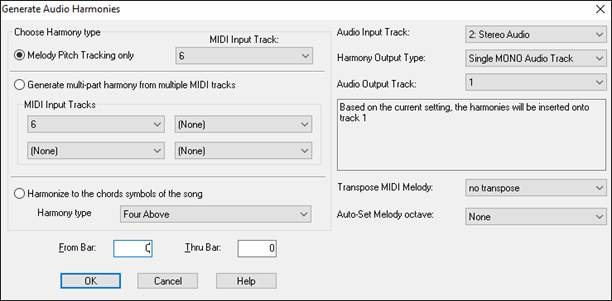- Track One Generator
- Msr Track 1 Generator
- Track 1 Generator Online
- Generate Track 1 From Track 2
- Generate Track 1 Data From Track 2
Convert fullz to track 1 & 2 using software At the legal area, this software and device are used to create ATM card including debit card, credit card and other card that use magnetic stripe as the machine receiver online.
ISO/IEC 7813 is an international standard codified by the International Organization for Standardization and International Electrotechnical Commission that defines properties of financial transaction cards, such as ATM or credit cards.[1]

If you'd like to create your own click loop, start in an empty GarageBand project, and create a Software Instrument track. With that track selected, go to the Library pane on the right, choose. You want to look at ISO 7813 for Track 1 & 2 generation. Depending on your gateway, however, they may reject cards other than the test cards they've given you. You might also want to warn them you're going to load test; I've had many card processors get very angry that we didn't tell them in advance that we were going to hammer their test system. Also, my single SWIPE contains BOTH track 1 and track 2 (in that order, track 1, a crlf and then track 2). According to the Wikipedia link in the original question, cards can have up to 3 tracks and readers might read tracks 1 and 2 both (or one or the other) and rarely track 3.
Track One Generator
Scope[edit]
The standard defines:[citation needed]
- physical characteristics, such as size, shape, location of magnetic stripe, etc.
- magnetic track data structures
Physical characteristics[edit]

ISO/IEC 7813 specifies the following physical characteristics of the card, mostly by reference to other standards:[citation needed]
- Embossed characters
- by reference to ISO/IEC 7811
- Embossing of expiration date
- the format (MM/YY or MM-YY)
- Magnetic stripe
- by reference to ISO/IEC 7811
- Integrated circuit with contacts
- by reference to ISO/IEC 7816-1
- Integrated circuit without contacts
- by reference to ISO/IEC 10536-1, ISO/IEC 14443-1, and ISO/IEC 15693-1
Magnetic tracks[edit]
Track 1[edit]
The Track 1 structure is specified as:[citation needed]
- STX : Start sentinel '%'
- FC : Format code 'B' (The format described here. Format 'A' is reserved for proprietary use.)
- PAN : Payment card number 4400664987366029, up to 19 digits
- FS : Separator '^'
- NM : Name, 2 to 26 characters (including separators, where appropriate, between surname, first name etc.)
- FS : Separator '^'
- ED : Expiration data, 4 digits or '^'
- SC : Service code, 3 digits or '^'
- DD : Discretionary data, balance of characters
- ETX : End sentinel '?'
- LRC : Longitudinal redundancy check, calculated according to ISO/IEC 7811-2
The maximum record length is 79 alphanumeric characters.
Examples[edit]
%B4815881002867896^YATES/EUGENE JOHN ^37829821000123456789?
%B4815881002861896^YATES/EUGENE L ^^^356858 00998000000?
Track 2[edit]

The Track 2 structure is specified as:[citation needed]
Msr Track 1 Generator
- STX : Start sentinel ';'
- PAN : Primary Account Number, up to 19 digits, as defined in ISO/IEC 7812-1
- FS : Separator '='
- ED : Expiration date, YYMM or '=' if not present
- SC : Service code, 3 digits or '=' if not present
- DD : Discretionary data, balance of available digits
- ETX : End sentinel '?'
- LRC : Longitudinal redundancy check, calculated according to ISO/IEC 7811-2
The maximum record length is 40 numeric digits (e.g., 5095700000000).[citation needed]
Track 3[edit]
Track 3 is virtually unused by the major worldwide networks and often isn't even physically present on the card by virtue of a narrower magnetic stripe.[citation needed]
Track 1 Generator Online
A notable exception to this is Germany, where Track 3 content was used nationally as the primary source of authorization and clearing information for debit card processing prior to the adoption of the 'SECCOS' ICC standards. Track 3 is standardized nationally to contain both the cardholder's bank account number and branch sort code (BLZ).[citation needed]
Programming[edit]
Parsing Track 1 and Track 2 can be done with Regular Expressions.
Track 1[edit]
^%B([0-9]{1,19})^([^^]{2,26})^([0-9]{4}|^)([0-9]{3}|^)([^?]+)?$

This Regex will capture all of the important fields into the following groups:[citation needed]
- Group 1: Payment card number (PAN)
- Group 2: Name (NM)
- Group 3: Expiration Date (ED)
- Group 4: Service Code (SC)
- Group 5: Discretionary data (DD)
Track 2[edit]
^;([0-9]{1,19})=([0-9]{4}|=)([0-9]{3}|=)([^?]+)?$
Generate Track 1 From Track 2
- Group 1: Primary Account Number (PAN)
- Group 2: Expiration date (ED)
- Group 3: Service code (SC)
- Group 4: Discretionary data (DD)

If you'd like to create your own click loop, start in an empty GarageBand project, and create a Software Instrument track. With that track selected, go to the Library pane on the right, choose. You want to look at ISO 7813 for Track 1 & 2 generation. Depending on your gateway, however, they may reject cards other than the test cards they've given you. You might also want to warn them you're going to load test; I've had many card processors get very angry that we didn't tell them in advance that we were going to hammer their test system. Also, my single SWIPE contains BOTH track 1 and track 2 (in that order, track 1, a crlf and then track 2). According to the Wikipedia link in the original question, cards can have up to 3 tracks and readers might read tracks 1 and 2 both (or one or the other) and rarely track 3.
Track One Generator
Scope[edit]
The standard defines:[citation needed]
- physical characteristics, such as size, shape, location of magnetic stripe, etc.
- magnetic track data structures
Physical characteristics[edit]
ISO/IEC 7813 specifies the following physical characteristics of the card, mostly by reference to other standards:[citation needed]
- Embossed characters
- by reference to ISO/IEC 7811
- Embossing of expiration date
- the format (MM/YY or MM-YY)
- Magnetic stripe
- by reference to ISO/IEC 7811
- Integrated circuit with contacts
- by reference to ISO/IEC 7816-1
- Integrated circuit without contacts
- by reference to ISO/IEC 10536-1, ISO/IEC 14443-1, and ISO/IEC 15693-1
Magnetic tracks[edit]
Track 1[edit]
The Track 1 structure is specified as:[citation needed]
- STX : Start sentinel '%'
- FC : Format code 'B' (The format described here. Format 'A' is reserved for proprietary use.)
- PAN : Payment card number 4400664987366029, up to 19 digits
- FS : Separator '^'
- NM : Name, 2 to 26 characters (including separators, where appropriate, between surname, first name etc.)
- FS : Separator '^'
- ED : Expiration data, 4 digits or '^'
- SC : Service code, 3 digits or '^'
- DD : Discretionary data, balance of characters
- ETX : End sentinel '?'
- LRC : Longitudinal redundancy check, calculated according to ISO/IEC 7811-2
The maximum record length is 79 alphanumeric characters.
Examples[edit]
%B4815881002867896^YATES/EUGENE JOHN ^37829821000123456789?
%B4815881002861896^YATES/EUGENE L ^^^356858 00998000000?
Track 2[edit]
The Track 2 structure is specified as:[citation needed]
Msr Track 1 Generator
- STX : Start sentinel ';'
- PAN : Primary Account Number, up to 19 digits, as defined in ISO/IEC 7812-1
- FS : Separator '='
- ED : Expiration date, YYMM or '=' if not present
- SC : Service code, 3 digits or '=' if not present
- DD : Discretionary data, balance of available digits
- ETX : End sentinel '?'
- LRC : Longitudinal redundancy check, calculated according to ISO/IEC 7811-2
The maximum record length is 40 numeric digits (e.g., 5095700000000).[citation needed]
Track 3[edit]
Track 3 is virtually unused by the major worldwide networks and often isn't even physically present on the card by virtue of a narrower magnetic stripe.[citation needed]
Track 1 Generator Online
A notable exception to this is Germany, where Track 3 content was used nationally as the primary source of authorization and clearing information for debit card processing prior to the adoption of the 'SECCOS' ICC standards. Track 3 is standardized nationally to contain both the cardholder's bank account number and branch sort code (BLZ).[citation needed]
Programming[edit]
Parsing Track 1 and Track 2 can be done with Regular Expressions.
Track 1[edit]
^%B([0-9]{1,19})^([^^]{2,26})^([0-9]{4}|^)([0-9]{3}|^)([^?]+)?$
This Regex will capture all of the important fields into the following groups:[citation needed]
- Group 1: Payment card number (PAN)
- Group 2: Name (NM)
- Group 3: Expiration Date (ED)
- Group 4: Service Code (SC)
- Group 5: Discretionary data (DD)
Track 2[edit]
^;([0-9]{1,19})=([0-9]{4}|=)([0-9]{3}|=)([^?]+)?$
Generate Track 1 From Track 2
- Group 1: Primary Account Number (PAN)
- Group 2: Expiration date (ED)
- Group 3: Service code (SC)
- Group 4: Discretionary data (DD)
References[edit]
- ^ISO/IEC 7813:2006 Information technology -- Identification cards -- Financial transaction cards
